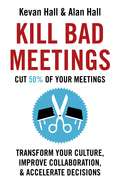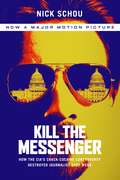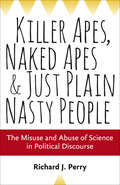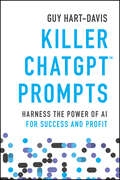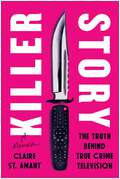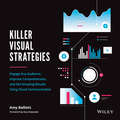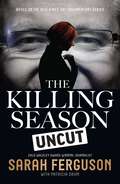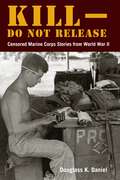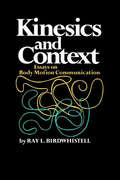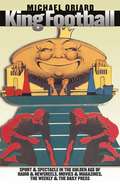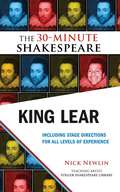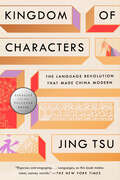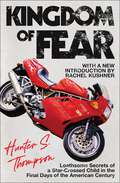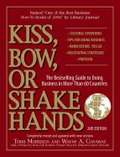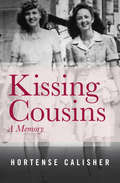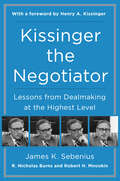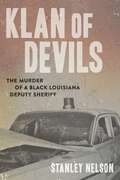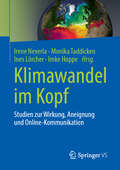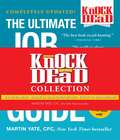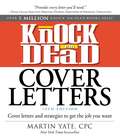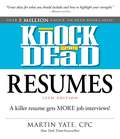- Table View
- List View
Kill Bad Meetings: Cut 50% of your meetings to transform your culture, improve collaboration, and accelerate decisions
by Kevan Hall Alan HallCUT 50% OF YOUR MEETINGS AND IMPROVE THE ONES THAT REMAINMeetings are essential to collaboration and decision making, but they are often irrelevant, time consuming and badly run. People spend an average of 2 days per week in meetings and 50% of it is wasted. This book will help you win back that wasted day a week by cutting out the half of face to face and virtual meetings that do not need to happen and radically improving the ones that remain.The two authors, one an experienced CEO and consultant to major multinationals, the other a millennial line manager working within one of the world's largest companies, find common ground, and occasional disagreements on creating new ways of meeting both face to face and through technology that are far more engaging and effective for everyone.The book focuses on three main areas:· Dealing with the business and corporate cultural challenges in changing the way we meet· Cutting out the unnecessary topics and participants that make up 50% of todays meetings· Designing and running faster and more focused face to face and online meetings with more relevant content; clearer decisions and actions, and much higher levels of participationFull of examples and practical tools that will improve everything from your regular team meetings to management meetings, online conferences, global meetings and big events. This book will lead you through practical actions and targets to kill the meetings that do not need to happen and radically improve the ones that remain.
Kill Bad Meetings: Cut 50% of your meetings to transform your culture,improve collaboration and accelerate decisions
by Kevan Hall Alan HallMeetings are probably the largest unmanaged cost area in large organizations. Today meetings consume about 40% of working time for managers and professionals (our most senior and expensive people). <P><P>People are frustrated with too many boring, irrelevant or badly run meetings. Research shows that managerial and professional people on average spend two days per week in meetings. <P><P>For business, this is a huge cost. <P><P>Kill Bad Meetings will show you how to cut out the unnecessary meetings, topics and participants that make many meetings irrelevant. Unlike other books looking at improving the effectiveness of meetings, this book starts with cancelling meetings altogether. <P><P>Kill Bad Meetings will show you how to save yourself several hours of time a week-so you can move on to focus on improving the planning and running of the remaining 50% of meetings that actually do need to happen.
Kill the Messenger: How the CIA's Crack-Cocaine Controversy Destroyed Journalist Gary Webb
by Nick Schou Introduction by Charles Bowden"Kill the Messenger" tells the story of the tragic death of Gary Webb, the controversial newspaper reporter who committed suicide in December 2004. Webb is the former San Jose Mercury News reporter whose 1996 oDark AllianceOCO series on the so-called CIA-crack cocaine connection created a firestorm of controversy and led to his resignation from the paper amid escalating attacks on his work by the mainstream media. Author and investigative journalist Nick Schou published numerous articles on the controversy and was the only reporter to significantly advance WebbOCOs stories. Drawing on exhaustive research and highly personal interviews with WebbOCOs family, colleagues, supporters and critics, this book argues convincingly that WebbOCOs editors betrayed him, despite mounting evidence that his stories were correct. "Kill the Messenger" examines the oDark AllianceOCO controversy, what it says about the current state of journalism in America, and how it led Webb to ultimately take his own life. WebbOCOs widow, Susan Bell, remains an ardent defender of her ex-husband. By combining her story with a probing examination of the one of the most important media scandals in recent memory, this book provides a gripping view of one of the greatest tragedies in the annals of investigative journalism. "
Killer Apes, Naked Apes, and Just Plain Nasty People: The Misuse and Abuse of Science in Political Discourse
by Richard J. PerryMisunderstood—or deliberately twisted—biological science leads to overheated rhetoric and bad policy.We like to think that science always illuminates. But the disturbing persistence of the concept of biological determinism—the false idea that human behavior is genetically fixed or inherently programmed and therefore is not susceptible to rapid change—shows that scientific research and concepts can be distorted to advance an inhumane and sometimes deadly political agenda. It was biological determinism that formed the basis of the theory of eugenics, which in turn led to the forced sterilization of "misfits" and the creation of Nazi death camps.In Killer Apes, Naked Apes, and Just Plain Nasty People, anthropologist Richard J. Perry delivers a scathing critique of determinism. Exploring the historical context and enduring popularity of the movement over the past century and a half, he debunks the facile and the reductionist thinking of so many popularizers of biological determinism while considering why biological explanations have resonated in ways that serve to justify deeply conservative points of view.Moving through time, from the prevalence of overt racism in the late nineteenth and early twentieth centuries to "human nature" arguments, from the rise of sociobiology in the 1970s to the current fixation on evolutionary psychology, the book argues that both history and cross-cultural studies amply demonstrate the human capacity for growth and self-determination. Clearly written, conversational, and rationally argued, this book promotes sound and careful research while skewering the bogus ideological assertions that have been used to justify colonialism, slavery, gender discrimination, neoliberal economic policies, and the general status quo.
Killer ChatGPT Prompts: Harness the Power of AI for Success and Profit
by Guy Hart-DavisUnlock the full capabilities of ChatGPT at work, at home, and in your day-to-day By now, you’ve heard of ChatGPT and its incredible potential. You may even have tried to use it a few times just to see it in action for yourself. But have you ever wondered what ChatGPT is truly capable of? Killer ChatGPT Prompts: Harness the Power of AI for Success and Profit will show you the true power of Large Language Models (LLMs) like ChatGPT. In the book, veteran IT educator and trusted author Guy Hart-Davis shows you the exact prompts he’s discovered to unlock a huge variety of expert business writing, like emails and proposals, data analysis use cases, lesson plans, information exchange scripts, and more! You’ll also find: The perfect prompts for a huge array of job roles, including those in sales and marketing, web development, HR, customer support, and more Use cases for ChatGPT in the home, with your kids, and in your relationship Hundreds more prompts that will make your job, your home life, and your day-to-day so much easierThere’s no doubt about it. LLMs—and ChatGPT—are here to stay. The only question is: Will you have the skills and the wherewithal to unleash its potential in your own life? Killer ChatGPT Prompts can guarantee that you will.
Killer Story: The Truth Behind True Crime Television
by Claire St. AmantFollow a journalist and TV producer from 48 Hours and 60 Minutes as she carves out a career in the ruthless, knives-out world of true crime television . . . one killer story at a time.Serial killers. Homicidal spouses. Sociopathic criminals. Claire St. Amant has met them all. She spent nearly a decade in network television chasing the biggest true crime stories in the country, including the murder of Chris Kyle, plastic-surgeon-turned-murder-for-hire suspect Thomas Michael Dixon, the Parkland high school mass shooting, the disappearance of Christina Morris, and serial killer Samuel Little. Bringing a true crime story to network television requires quick thinking and tenacious stamina, and in her debut memoir, Claire offers true crime fans a rare in-depth look from the other side of the yellow tape. In Killer Story, readers will learn what it really takes to get these gripping cases on the air with insights such as: How it feels to share space with a dead-eyed murderer Which TV show has a reputation for &“eating their young&” How reporters win over skeptical cops and reluctant lawyers Why TV journalists are always racing against the clock—and competitor sabotage What happens when a district attorney decides journalists have committed a felony The unresolved crimes that still haunt Claire to this day This eye-opening look behind the scenes of true crime television offers an unforgettable read—and a window into the daily reality of investigative journalism.
Killer Visual Strategies: Engage Any Audience, Improve Comprehension, and Get Amazing Results Using Visual Communication
by Amy BalliettDiscover the foundation, power, and necessity of visual communication with this essential guide Visual communication has changed. It’s gone from being an optional medium for relaying information to an important method for building connections and increasing understanding. We now use visual storytelling to help us establish and strengthen relationships, engage distracted audiences, and bring clarity to complexity. Killer Visual Strategies examines how visual communication has transformed how brands connect with their customers and colleagues alike. It looks at the growing audience demand for quality visual content and how organizations must meet this demand or risk being left behind. Killer Visual Strategies traces the history of visual communication and explores why it now plays an integral role in our daily lives. As Amy Balliett tells the story of this evolving medium, she naturally incorporates visuals, such as timelines and data visualizations throughout. In addition to providing actionable rules to follow for creating high-impact visual content, Balliett also explores the latest trends, including visual search, augmented reality (AR), and virtual reality (VR). Then, she looks forward to what lies ahead in this dynamic field. The book’s topics can benefit readers in a range of professions where visual content is now vital to sharing a message. Learn best practices for visual communication Gain inspiration from countless visual examples Stay on top of the latest trends in visual communication Understand visual communication for marketing, sales, design, HR, and more Killer Visual Strategies provides a clearer picture of the evolution of visual communication as a fundamental part of how a story is told.
Killing Season Uncut
by Sarah Ferguson Patricia DrumAustralians came to the ABC's The Killing Season in their droves, their fascination with the Rudd-Gillard struggle as unfinished as the saga itself.Rudd and Gillard dominate the drama as they strain to claim the narrative of Labor's years in power. The journey to screen for each of their interviews is telling in itself. Kevin Rudd gives his painful account of the period and recalled in vivid detail the events of losing the prime ministership. Julia Gillard is frank and unsparing of her colleagues.More than a hundred people were interviewed for The Killing Season—ministers, backbenchers, staffers, party officials, pollsters and public servants—recording their vivid accounts of the public and private events that made the Rudd and Gillard governments and then brought them undone. It is a damning portrait of a party at war with itself: the personal rivalries and the bitter defeats that have come to define the Rudd-Gillard era."The making of The Killing Season matched the drama on screen and that's a story we wanted to tell. And now we have a place for the episodes of rich material we could have put into a 5-part series." — Sarah Ferguson
Killing the Messenger: The Right-Wing Plot to Derail Hillary and Hijack Your Government
by David BrockNew York Times bestselling author and founder of Media Matters, David Brock takes readers on his daring and eye-opening odyssey through the maze of political trenches.<P><P> David Brock is the ultimate happy warrior. Once a leading right-wing hit man, Brock is now the Left's pre-eminent defender and truth-teller. <P> In this incisive, personal account, Brock disarms the major tentacles of the Republican Leviathan: the Koch Brothers, the Clinton haters, and the Fox Noise Machine. With the acumen of a seasoned political player, Brock takes readers inside his Democratic war rooms and their 24/7 battles with right-wing forces for control of the story lines and messages that will decide the 2016 election. And he chronicles his own evolution from lead Clinton attack-dog to one of Hillary Clinton's fiercest defenders as he knocks down the conservative case against her.<P> Finally, KILLING THE MESSENGER provides the no holds barred playbook for what the new right-wing conspirators will do in this election cycle to tear apart the electorate-and what good, engaged, and informed citizens can do to stop them.
Kill–Do Not Release: Censored Marine Corps Stories from World War II (World War II: The Global, Human, and Ethical Dimension)
by Douglass K. Daniel“Fighter-Writer” reports from major battles in the Pacific highlight what America’s Marines endured in World War IIDouglass K. Daniel presents a fascinating trove of previously classified material withheld from the public because of government and public relations concerns at the time, including tactical details that could inadvertently aid the enemy, battlefield gore that could disturb readers, and the gamut of issues of taste. Navy censors in the field and editors at Marine Corps headquarters in Washington were also on alert for any material that could negatively affect the Corps itself or the overall war effort. Soul-searching stories that questioned the nature of war were rejected lest they sow doubt stateside about the cause for which so many lives were being lost.Behind the bylines was a new breed of storytellers. Considered “fighter-writers,” Marine combat correspondents, or CCs, carried typewriters as well as weapons. The Marine Corps Division of Public Relations recruited them from America’s newsrooms to join the fight that stretched from Guadalcanal and the bloody assault on Tarawa to the black sands of Iwo Jima and the dense jungles of Okinawa. Their approved work appeared in civilian newspapers, magazines, and other national and local media.This collection also highlights the unique efforts of the CCs and the public relations officers who commanded them. While they were assigned to report and write, they were Marines first. They eagerly put aside their notebooks to take up arms against the enemy as needed. Many were wounded in battle, and more than a dozen were killed, giving their lives to get the story behind the most significant conflict in human history.
Kinesics and Context
by Ray L. BirdwhistellRay L. Birdwhistell, in this study of human body motion (a study he terms kinesics), advances the theory that human communication needs and uses all the senses, that the information conveyed by human gestures and movements is coded and patterned differently in various cultures, and that these codes can be discovered by skilled scrutiny of particular movements within a social context.
King Football
by Michael OriardThis landmark work explores the vibrant world of football from the 1920s through the 1950s, a period in which the game became deeply embedded in American life. Though millions experienced the thrills of college and professional football firsthand during these years, many more encountered the game through their daily newspapers or the weekly Saturday Evening Post, on radio broadcasts, and in the newsreels and feature films shown at their local movie theaters. Asking what football meant to these millions who followed it either casually or passionately, Michael Oriard reconstructs a media-created world of football and explores its deep entanglements with a modernizing American society.Football, claims Oriard, served as an agent of "Americanization" for immigrant groups but resisted attempts at true integration and racial equality, while anxieties over the domestication and affluence of middle-class American life helped pave the way for the sport's rise in popularity during the Cold War. Underlying these threads is the story of how the print and broadcast media, in ways specific to each medium, were powerful forces in constructing the football culture we know today."[Oriard] captures the self-aggrandizing illogic of the game's cultural role in his absorbing study of early 20th-century culture.--New York Times"This excellent book should be required reading on any American Studies course worth the name. . . . Oriard's detailed and well-written work shows us how the game has been constructed through notions of national, gendered and ethnic--and, as he insists, also class--identities.--Journal of American StudiesIn this landmark work exploring the vibrant world of football from the 1920s through the 1950s, Michael Oriard explores how the mass media shaped and were shaped by the exploding popularity of football. King Football is at once a sweeping cultural history of football, a provocative study of the power of print and broadcast media, and a compelling investigation of American attitudes about race, class, and gender and their relationship to sport.-->
King Lear: The 30-Minute Shakespeare
by Nick NewlinKing Lear: The 30-Minute Shakespeare renders six powerful scenes from this enduring tragedy. Starting with Lear's banishment of Cordelia, the plot advances irresistibly, featuring scenes of brother Edmund's villainous plotting and the Fool's witty, weighty wordplay.The action climaxes with the storm on the heath, where Lear and Poor Tom rail in exquisite madness. The abridgement concludes with moving scenes of Cordelia's tender reconciliation with King Lear and their heart-rending demise.The edition includes helpful advice by Nick Newlin on how to put on a Shakespeare production in a high school class with novice actors, as well as tips for performing the specific play and recommendations for further resources.
Kingdom of Characters: The Language Revolution That Made China Modern
by Jing TsuWhat does it take to reinvent a language?After a meteoric rise, China today is one of the world&’s most powerful nations. Just a century ago, it was a crumbling empire with literacy reserved for the elite few, as the world underwent a massive technological transformation that threatened to leave them behind. In Kingdom of Characters, Jing Tsu argues that China&’s most daunting challenge was a linguistic one: the century-long fight to make the formidable Chinese language accessible to the modern world of global trade and digital technology.Kingdom of Characters follows the bold innovators who reinvented the Chinese language, among them an exiled reformer who risked a death sentence to advocate for Mandarin as a national language, a Chinese-Muslim poet who laid the groundwork for Chairman Mao's phonetic writing system, and a computer engineer who devised input codes for Chinese characters on the lid of a teacup from the floor of a jail cell. Without their advances, China might never have become the dominating force we know today.With larger-than-life characters and an unexpected perspective on the major events of China&’s tumultuous twentieth century, Tsu reveals how language is both a technology to be perfected and a subtle, yet potent, power to be exercised and expanded.
Kingdom of Fear: Loathsome Secrets of a Star-Crossed Child in the F
by Hunter S. ThompsonThe Gonzo memoir from one of the most influential voices in American literature, Kingdom of Fear traces the course of Hunter S. Thompson’s life as a rebel—from a smart-mouthed Kentucky kid flaunting all authority to a convention-defying journalist who came to personify a wild fusion of fact, fiction, and mind-altering substances.Brilliant, provocative, outrageous, and brazen, Hunter S. Thompson's infamous rule breaking—in his journalism, in his life, and under the law—changed the shape of American letters, and the face of American icons. Call it the evolution of an outlaw. Here are the formative experiences that comprise Thompson’s legendary trajectory alongside the weird and the ugly. Whether detailing his exploits as a foreign correspondent in Rio, his job as night manager of the notorious O’Farrell Theatre in San Francisco, his epic run for sheriff of Aspen on the Freak Power ticket, or the sensational legal maneuvering that led to his full acquittal in the famous 99 Days trial, Thompson is at the peak of his narrative powers in Kingdom of Fear. And this boisterous, blistering ride illuminates as never before the professional and ideological risk taking of a literary genius and transgressive icon.
Kirk and Anne: Letters of Love, Laughter, and a Lifetime in Hollywood (Turner Classic Movies)
by Kirk Douglas Anne Douglas Michael Douglas Marcia NewbergerFilm legend Kirk Douglas and Anne Buydens, his wife of nearly sixty-three years, look back on a lifetime filled with drama both on and off the screen. Sharing priceless correspondence with each other as well as the celebrities and world leaders they called friends, Kirk and Anne is a candid portrayal of the pleasures and pitfalls of a Hollywood life lived in the public eye. Compiled from Anne's private archive of letters and photographs, this is an intimate glimpse into the Douglases' courtship and marriage set against the backdrop of Kirk's screen triumphs, including The Vikings, Lust For Life, Paths of Glory, and Spartacus. The letters themselves, as well as Kirk and Anne's vivid descriptions of their experiences, reveal remarkable insight and anecdotes about the legendary figures they knew so well, including Lauren Bacall, Frank Sinatra, Burt Lancaster, Elizabeth Taylor, John Wayne, the Kennedys, and the Reagans. Filled with photos from film sets, private moments, and public events, Kirk and Anne details the adventurous, oftentimes comic, and poignant reality behind the glamour of a Hollywood life-as only a couple of sixty-two years (and counting) could tell it.
Kiss, Bow, Or Shake Hands: The Bestselling Guide to Doing Business in More Than 60 Countries, Second Edition (Kiss, Bow Or Shake Hands Series)
by Terri Morrison Wayne A. ConawayThis is a guide to proper international business protocol. With countries such as China and India taking on a more significant role in the global business landscape, you can't afford not to know the practices, customs, and philosophies of other countries.
Kissing Cousins: A Memory
by Hortense CalisherHortense Calisher&’s evocative memoir bristles with intelligence and youthful inquiryKissing Cousins recalls the author as a teenager: peppy, earnest, and a bit self-important. Hortense Calisher documents her family&’s surprising history as Southern Jews adrift in New York. Finding her new city and school boorish, the young Calisher takes solace in the enduring friendship she develops with Katie Pyle, a gregarious nurse turned &“kissing cousin&” fifteen years Calisher&’s senior. Katie, an unmarried woman, possesses her own secret, depicted here with a novelist&’s touch for the dramatic. Kissing Cousins tackles matters of aging, life, and death with the sensitivity and eloquence readers have come to expect from Hortense Calisher.
Kissinger the Negotiator: Lessons from Dealmaking at the Highest Level
by James K. Sebenius Robert H. Mnookin R. Nicholas Burns“A straightforward examination of Kissinger’s finely honed skills . . . offers keen insight for anyone interested or involved in negotiations at any level.”—James A. Baker III, sixty-first U.S. secretary of stateIncludes a foreword by Henry KissingerIn this groundbreaking, definitive guide to the art of negotiation, three Harvard professors—all experienced negotiators—offer a comprehensive examination of one of the most successful dealmakers of all time.Politicians, world leaders, and business executives around the world—including eleven consecutive US presidents—have sought the counsel of Henry Kissinger, a brilliant diplomat and historian whose unprecedented achievements as a negotiator have been universally acknowledged. The first book of its kind, Kissinger the Negotiator provides a clear analysis of Kissinger’s overall approach to making deals and resolving conflicts—expertise that holds powerful and enduring lessons.James K. Sebenius (Harvard Business School), R. Nicholas Burns (Harvard Kennedy School of Government), and Robert H. Mnookin (Harvard Law School) crystallize the key elements of Kissinger’s approach, based on in-depth interviews with the former secretary of state himself about some of his most difficult negotiations, an extensive study of his record, and many independent sources. Taut and instructive, Kissinger the Negotiator mines the long, fruitful career of this elder statesman and shows how his strategies apply not only to contemporary diplomatic challenges but to other realms of negotiation, including business, public policy, and law.Essential reading for current and future leaders, Kissinger the Negotiator is an invaluable guide to reaching agreements in challenging situations.“A very readable and informative book that will serve future negotiators well. It also presents a new look at the importance of Henry Kissinger’s role in forming the world in which we now live.” —Booklist“An all-star trio of experts on negotiation in business, law, and diplomacy [has] done a great service in elucidating the actions of a very skilled American diplomat.” —The New York Times Book Review“This book, based on deep interviews and research, shows [Kissinger’s] strengths and weaknesses [and] the lessons to be learned.”—Walter Isaacson, #1 New York Times–bestselling author of Elon Musk and Kissinger: A Biography
Klan of Devils: The Murder of a Black Louisiana Deputy Sheriff
by Stanley NelsonIn the summer of 1965, several Ku Klux Klan members riding in a pickup truck shot two Black deputies on patrol in Washington Parish, Louisiana. Deputy Oneal Moore, the driver of the patrol car and father of four daughters, died instantly. His partner, Creed Rogers, survived and radioed in a description of the vehicle. Less than an hour later, police in Mississippi spotted the truck and arrested its driver, a decorated World War II veteran named Ernest Ray McElveen. They returned McElveen to Washington Parish, where he spent eleven days in jail before authorities released him. Afterward, the FBI sent its top inspector to Bogalusa, Louisiana, to participate in the murder inquiry—the only civil rights–era FBI investigation into the killing of a Black law enforcement officer by the KKK. Despite that assistance, lack of evidence and witnesses unwilling to come forward forced Louisiana prosecutors eventually to drop all charges against McElveen. The FBI continued its investigation but could not gather enough evidence to file charges, leaving the murder of Oneal Moore unsolved. Klan of Devils: The Murder of a Black Louisiana Deputy Sheriff is Stanley Nelson’s investigation of this case, which the FBI probed from 1965 to 2016. Nelson describes the Klan’s growth, and the emergence of Black activism in Bogalusa and Washington Parish, against the backdrop of political and social change in the 1950s and early 1960s. With the assistance of two retired FBI agents who worked the case, Nelson also explores the lives of the primary suspects, all of whom are now dead, and points to the Klansmen most likely responsible for the senseless and horrific attack.
Klimawandel im Kopf: Studien zur Wirkung, Aneignung und Online-Kommunikation
by Monika Taddicken Irene Neverla Ines Lörcher Imke HoppeKlimawandel ist ein Meta-Thema - seit Jahrzehnten auf der Agenda der Medien, global diskutiert, mit vielen Anschlusspunkten in politische, wirtschaftliche, kulturelle Fragen und Alltagsbelange. Was aber findet sich in den Köpfen der Menschen zum Thema Klimawandel? Welche Kommunikationskanäle, welche journalistischen und welche Online-Angebote waren dafür wichtig, und wie hängen Wissen, Einstellungen und Verhaltensbereitschaften damit zusammen? Die mit verschiedenen Methoden erarbeiteten Ergebnisse in diesem Buch zeigen, wie ,eigensinnig' bzw. kreativ sich Menschen das Thema Klimawandel aneignen, wie vielfach vernetzt und ,rhizomartig' die klimabezogene Kommunikation verläuft.
Knock 'em Dead Collection: Knock 'em Dead; Knock 'em Dead Cover Letters; Knock 'em Dead Resumes (Knock 'em Dead)
by Martin YateNew York Times bestselling author Martin Yate has helped millions of people turn their lives around by finding great jobs and managing their careers more effectively. Now his unique and proven secrets to success can be found in one place: the Knock ’em Dead Collection.Inside, you’ll find everything you need to make a successful next step: *Knock ’em Dead: The Ultimate Job Search Guide *Knock ’em Dead Cover Letters *Knock ’em Dead Resumes Whether you’re making a strategic career move or seeking your first job, with the Knock ’em Dead Collection, you’ll be better prepared to navigate the twists and turns of a long and successful career.
Knock 'em Dead Cover Letters: Cover Letters and Strategies to Get the Job You Want
by Martin YateCover letters that get noticed, get read, and get the interview! In the newest edition of his classic cover letter guide, job search expert Martin Yate shows you how to dramatically increase your chance of landing an interview. The key, as Yate explains, is to use language drawn from the job posting itself, words that will send your application to the top of database searches. In this completely updated guide, you'll find numerous sample cover letters, along with Yate's tried and proven methods to:Determine relevant keywords to get attention--and use them effectivelyClearly display your personal brand and the transferable skills you bring to the jobFind the right contact information that gets your material in front of decision-making managers and recruitersUse social media sites such as LinkedIn to create an effective online profile and build professional and personal networksWith Martin Yate's expert advice, you'll create unique and compelling cover letters that will grab employers' attention and get you in the door!
Knock 'em Dead Cover Letters: Cover Letters and Strategies to Get the Job You Want
by Martin Yate<p>Cover letters that get noticed, get read, and get the interview! <p>In the newest edition of his classic cover letter guide, job search expert Martin Yate shows you how to dramatically increase your chance of landing an interview. The key, as Yate explains, is to use language drawn from the job posting itself, words that will send your application to the top of database searches. In this completely updated guide, you'll find numerous sample cover letters, along with Yate's tried and proven methods to: <p> <li>Determine relevant keywords to get attention--and use them effectively <li>Clearly display your personal brand and the transferable skills you bring to the job <li>Find the right contact information that gets your material in front of decision-making managers and recruiters <li>Use social media sites such as LinkedIn to create an effective online profile and build professional and personal networks</li> <p> <p>With Martin Yate's expert advice, you'll create unique and compelling cover letters that will grab employers' attention and get you in the door!</p>
Knock 'em Dead Resumes: A Killer Resume Gets MORE Job Interviews!
by Martin YateExpert advice on building a resume to get the job you want! Your resume is the most important financial document you'll ever create. When it works, so do you. Drawing on more than thirty years of experience, bestselling author Martin Yate shows you how to write a dynamic, effective resume that:Stands out in a resume databaseBuilds a strong personal brand employers will want on their teamPasses recruiters' six-second scan testSpeaks to exactly what employers are looking forThe new edition of this classic guide includes dozens of sample resumes as well as cutting-edge advice on resume-writing tactics. With Knock 'em Dead Resumes, 12th Edition, you'll grab employers' attention--and score the job you want.

